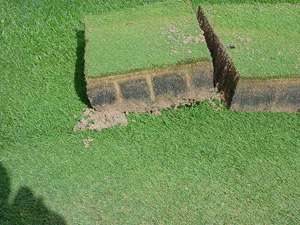Plants need a healthy balanced soil for optimal root zone health and plant health. When the soil environment is contaminated it can create an area known as “black layer.” We see this often in turf grass, where the tendency is to over-water the top of the plant, making the soil unhealthy with an anaerobic area.

Black layer can be developed from other environmental impacts, including contamination by hydro-carbons and other chemicals.
The nature of the materials known as black – layer is that the aerobic microbes (bacteria) have been stressed, where they no longer can be viable in doing their job in the soil.
The impact causes an anaerobic area. This area turns black, thus the name ‘Black Layer.’
The challenge with any area that is developing an anaerobic zone in the soil, is that 1) the condition that is impacting the zone to go anaerobic needs to be addressed. And 2) the soil health needs to be treated to return it back where the first 12″ of the soil can be actively using the aerobic bacteria to do the work of creating a healthy root zone and the healthy plant.
In soils that have been impacted by hydro-carbon spills, the treatment methodology needs to include remediation of the hydrocarbon, whether it is from an oil spill, or gasoline spill.
The material needs to be digested (not just dispersed), so the aerobic bacteria has a chance to start producing and being viable.
The benefit of a program that has healthy microbiology and balanced nutrients. BioLynceus provides programs that restore the health of the soil, while remediating the hydro-carbons.
Improving the food-web of the soils includes restoration of the balanced biology of the soils, reducing the amount of compaction by adding floculation of the soils while rebalancing the soil health.
Soils can quickly become starved for the right balance of nutrient and microbiology. With BioLynceus programs an environmentally sensitive solutions is available to clients to restore soil health and plant health.


